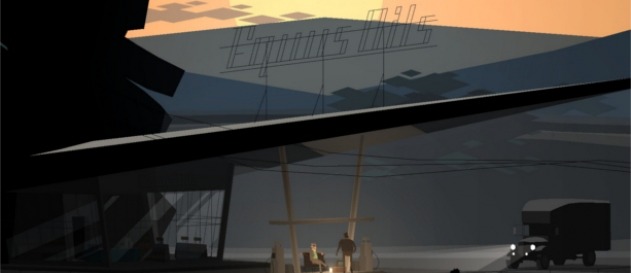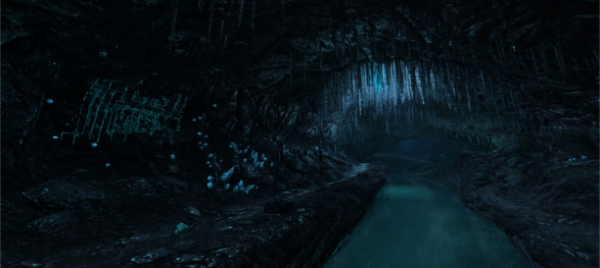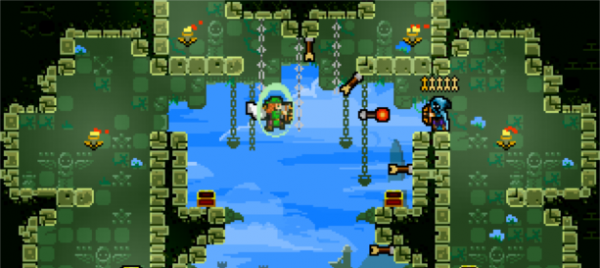
I spent most of Thanksgiving weekend 2013 hunched over my laptop playing video games, a form of entertainment that I haven’t actively engaged with since the heyday of Goldeneye. Though my parents and wife worried about some kind of fundamental regression, it was actually for you, dear readers, that I spent hours navigating dark tunnels, solving puzzles, and blasting at evil aliens.
This weekend at Museum of the Moving Image sees the launch of Indie Essentials: 25 Must-Play Video Games, a fully interactive exhibit featuring some of the best recent games from the indie scene. Far from Halo, World of Warcraft, Grand Theft Auto and their ilk, these games feature highly idiosyncratic, often very personal ideas of what the term “video game” can mean. I interviewed IndieCade Festival Director Sam Roberts about the history of this exploding movement in gaming.
Sloan Science and Film: Can you define what an "indie game" is and talk a little bit about the history of the movement?
Sam Roberts: 'Indie' doesn't have a specific definition, which I think is both a blessing and a curse. It leads to a lot of handwringing about what is ‘indie’, how one qualifies, and a feeling that maybe it means nothing at all—none of which are good things. But by not having a specific cut-and-dried definition of indie, it has allowed the term to be inclusive up to this point—to be a movement that is open to hobbyists, students, experimentalists, punks, small developers, marginalized developers and more. For me, 'indie' is about exploring the spaces unexplored, whether in game mechanics, game story, or even game economies and the structure of your business. It’s a freedom from answering the demands of funders, and this generally correlates to a much lower recoupment target for the games, allowing developers to pursue these unexplored spaces. I believe this is the fundament of 'indie.’
Early in the history of game development, there were no established practices or genres, and investments in a single game were low enough that there was freedom to experiment. As budgets rose, and genres and audience were established, risk analysis forced the industry into repeatedly making the same games, with slight tweaks. The indie movement comes from many, many different places, but generally represents developers that were no longer interested in the mainstream products, whether because they desired innovation, or different content, or games featuring a wider viewpoint.

SSF: Is there something about the technology available at this moment in video game development that has made the indie game possible? It seems like there has been an explosion in the space in recent years.
SR: Dissatisfaction with mainstream games grew alongside a growing depth of knowledge in code and increasingly cheaper and easier to use tools for creating games. Programs like Gamemaker, Game Salad, Scratch, Twine, and others have put game making tools in the hands of individuals who until very recently would have had no way to express themselves in this medium. Couple that with a growing audience of young people who inherently want to express themselves via digital technology and games (it is their natural form of expression) and the recent explosion seems almost inevitable.
SSF: One thing that's struck me about a bunch of these games is that there's an emphasis on immersive storytelling over traditional game rewards. Dear Esther and Gone Home aren't even "games" in the traditional sense that I've been familiar with and Kentucky Route Zero features a strong narrative arc broken up into episodes, almost like an old-time serial. Is this something new or widespread in the evolution of the indie game?
SR: I believe that this desire to be expressive with technology, interaction, and games means that more and more individuals who are not married to systemic thinking or to classic game genres are investigating the space, and more and more are simply using the tools to tell the stories they want to tell. For one developer that could mean developing a strong underlying system that is exposed through use, where for another that could mean developing a strong underlying world and story that is revealed through exploration. The focus of the new age developer is on the experience of the player, and how that is shaped, rather than the formal aspects of the media as a frame.
SSF: The exhibition features a wide variety of aesthetics. Towerfall, Passage and Today I Die borrow from the graphics of earlier-era games, while Diner Dash, Canabalt and N v2.0 feel simple yet sleekly contemporary. Then you have games like Machinarium, Kentucky, and Dear Esther that all suggest really distinct expressionistic visions. What I'm not seeing in the bunch are games that attempt to achieve the kind of hyperreality we associate with more famous games that are popular enough to be advertised on television. Is the indie game interest in the antiquated, simple and handmade a function of technological limitations or is it something like a community reaction to the look of mainstream games?
SR: I think it is a little of both. At the beginning of the indie movement, all mainstream games were judged on their closeness to an ideal of 'realism'—games that looked like real life, that used more polygons and natural animations were considered inherently better. Early indie developers were definitely constrained from competing with those 'realistic' graphics (at the time, the cost of producing such assets was simply too high) and sought to differentiate themselves through different aesthetics. As the movement got stronger, growing off of some early successes and dovetailing with a strong sense of love and nostalgia on the part of the developers for classic genres, I think that initial impulse to create a different feel melded with and slowly shifted into a strong nostalgia-driven graphics interest. That may already be fading, though, as I find the scene moving towards more of a contemporary handmade look, something definitively different, but not derivative of old styles in the same way. The scene now needs ways to continue to differentiate itself and distinct visual look is a very strong one.

SSF: I also find the playability of these games so simple and intuitive (except, of course, QWOP, which has maddened me for hours, though its unplayability seems part of the point). Is this simplicity a reaction to controllers with tons of buttons and highly complicated gameplay?
SR: This simplicity is partially a reaction to overly complex controllers and gameplay, but is more driven by a desire for games that are welcoming to new audiences. Those complex controllers and established overly complex genres have reached the point where they do not invite a new player in—they are designed for players who are already familiar with the particular genre or series. Indie devs come from a diverse set of backgrounds, and have a diverse set of interests, and are in some ways dependent on getting folks who do not usually purchase games to be interested in theirs. This drives a strong move towards making games that are playable by and approachable for regular folks, and hence the intuitive, simple ways to engage.

SSF: Since this is a science blog, I can’t help but note that science pops up pretty regularly as a thematic element in many of these games. What’s behind the ongoing fascination with mixing science with games?
SR: I think this is partially due to the retro nostalgia (an equal number of folks in and around the scene love Nikola Tesla as much as “Mario Mario”). But I do think that, culturally, the folks that grew up being impressed by and immersed in technological advances and computers over the last several decades are 'science-first' in a very true sense, and like to nod to scientists past and present, and include their knowledge of science in the games they are making. Games are a great way to explore all kinds of questions. You can design systems and interactions around those questions, and play in them, finding answers and ideas you did not know were available. So people interested in games often use them to explore ideas they find interesting and exciting, including science.

SSF: What constitutes for you a "must play"?
SR: I don't know that I have an answer to this question—my list of must play games is far too long at this point! But I make a real point of playing anything that has an interesting new narrative mechanic, and I personally like to engage with as many tactical style games as I can. I love richness in choice and I really like moments where I can make loaded choices and see their results making large changes in the game space.
Indie Essentials: 25 Must-Play Video Games runs Dec 14, 2013 to Mar 2, 2014.
TOPICS